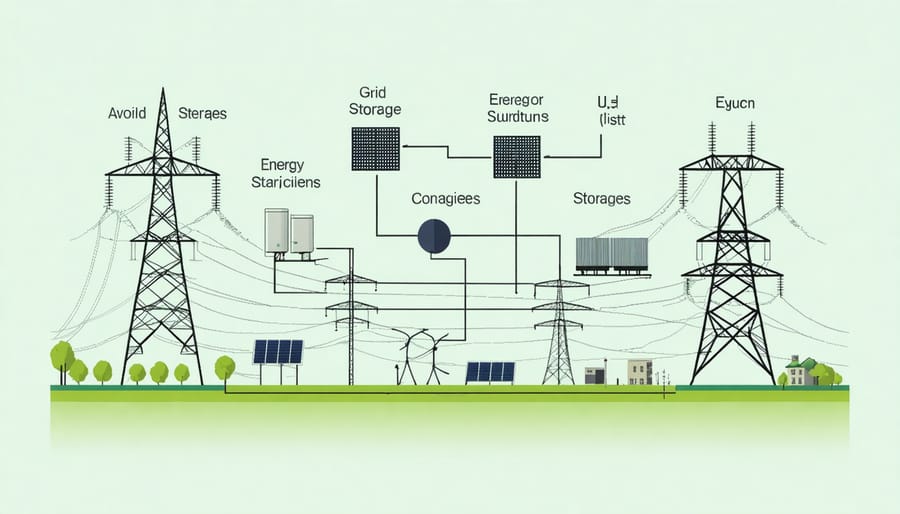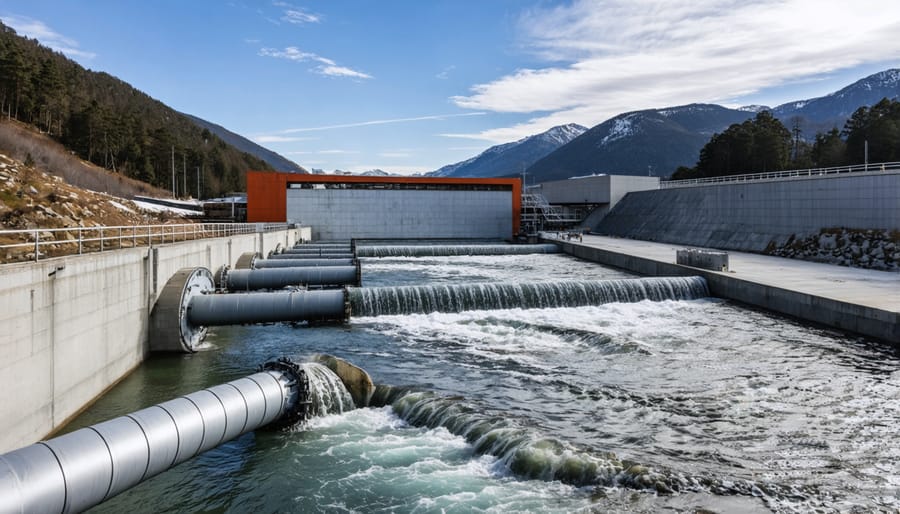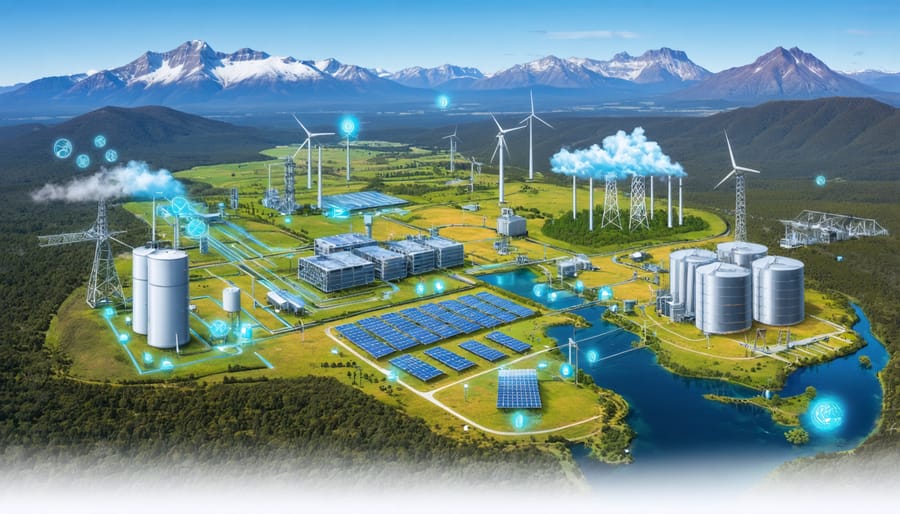In the race towards a renewable energy future, advanced energy storage stands as the cornerstone of sustainable power systems. Australia’s vast renewable resources and growing energy demands have catalyzed unprecedented innovations in storage technology, transforming how we capture, store, and distribute power across the continent.
From grid-scale batteries revolutionizing South Australia’s energy landscape to emerging hydrogen storage facilities in Western Australia, these technologies are reshaping our energy infrastructure. The integration of smart storage solutions has already reduced electricity costs by up to 30% in pilot communities while strengthening grid resilience during extreme weather events.
As climate challenges intensify, advanced energy storage offers more than just backup power—it provides the missing link between intermittent renewable generation and reliable, 24/7 clean energy access. With Australian businesses and communities leading the charge in adopting these technologies, we’re witnessing the dawn of a new energy era where storage solutions play a pivotal role in securing our sustainable future.
The question isn’t whether advanced energy storage will transform our power systems—it’s how quickly we can scale these solutions to meet tomorrow’s energy challenges.
Why Australia Needs Advanced Energy Storage Now
The Intermittency Challenge
Renewable energy sources like solar and wind have transformed our energy landscape, but their variable nature presents a unique challenge. When the sun sets or the wind dies down, power generation drops, creating what industry experts call the “duck curve” – periods where energy demand and supply are mismatched.
Advanced energy storage systems are the game-changing solution to this intermittency challenge. By capturing excess energy during peak production periods and releasing it when needed, storage technologies effectively smooth out these fluctuations. In Australia, where solar adoption rates are among the world’s highest, large-scale batteries are already proving their worth.
Take South Australia’s Hornsdale Power Reserve, for example. This massive battery installation has demonstrated how storage can respond to supply gaps within milliseconds, maintaining grid stability during unexpected outages. Community-scale batteries are also emerging across suburban areas, helping neighbourhoods balance their local energy needs while reducing strain on the main grid.
This ability to store and dispatch power on demand isn’t just convenient – it’s essential for creating a reliable, 100% renewable energy future.
Grid Stability in Remote Areas
Australia’s vast outback presents unique challenges for maintaining reliable power supply, with remote communities often situated hundreds of kilometres from the main electricity grid. These communities have traditionally relied on diesel generators, but advanced energy storage systems are revolutionising how we power the bush.
Battery storage technologies, particularly when paired with solar installations, are proving to be game-changers for remote areas. Communities like Coober Pedy in South Australia have demonstrated how hybrid systems can provide stable, around-the-clock power while significantly reducing diesel consumption.
The integration of smart microgrids with advanced storage capabilities has enabled remote mining operations and Indigenous communities to achieve energy independence. These systems automatically balance power supply and demand, ensuring consistent electricity delivery even during extreme weather events.
What’s particularly exciting is how these storage solutions are becoming more robust and weather-resistant, specifically designed to withstand the harsh Australian climate. From the scorching heat of the Pilbara to the cyclone-prone regions of Northern Queensland, new storage technologies are being adapted to local conditions, providing reliable power while reducing environmental impact and operational costs.
Breakthrough Storage Technologies Transforming Our Grid
Advanced Battery Systems
The landscape of advanced battery technologies continues to evolve rapidly, offering increasingly sophisticated solutions for energy storage challenges. Flow batteries have emerged as game-changers in grid-scale applications, particularly in remote Australian communities. These innovative systems store energy in liquid electrolytes, allowing for extended storage duration and virtually unlimited cycling capacity – a perfect match for our country’s harsh conditions and renewable energy needs.
Solid-state batteries represent another breakthrough, promising higher energy density and enhanced safety compared to traditional lithium-ion batteries. Australian researchers are at the forefront of developing these next-generation storage solutions, with several successful pilot projects already demonstrating their potential in both residential and commercial applications.
The integration of artificial intelligence and smart management systems has revolutionized battery performance optimization. Modern battery systems can now predict usage patterns, respond to grid demands in real-time, and automatically adjust charging cycles to maximize efficiency and lifespan.
Notably, the development of sustainable materials in battery production has gained significant momentum. Australian companies are pioneering the use of recycled materials and exploring alternatives to rare earth elements, making battery storage more environmentally friendly and cost-effective. These innovations are helping to create a more resilient and sustainable energy future while supporting local manufacturing and technological advancement.
Pumped Hydro Storage
Australia’s vast landscape and unique topography make it an ideal location for pumped hydro potential, offering a robust solution for large-scale energy storage. The Snowy 2.0 project, currently under development in the Snowy Mountains, stands as a testament to this potential, promising to add 2,000 megawatts of dispatchable clean energy to the national grid.
Across the country, researchers have identified over 22,000 potential sites suitable for pumped hydro storage, with just a fraction of these capable of storing more energy than Australia’s entire daily electricity needs. The technology works by pumping water uphill when energy is abundant and releasing it through turbines when demand peaks, effectively creating a giant natural battery.
Notable projects like Tasmania’s Battery of the Nation initiative demonstrate how pumped hydro can transform entire regions into renewable energy powerhouses. The scheme aims to double Tasmania’s renewable energy capacity and provide reliable backup power to mainland Australia.
What makes pumped hydro particularly attractive for Australia is its long operational life – typically 50 to 100 years – and its ability to provide stable, on-demand power that complements our growing solar and wind resources. Current developments are focusing on closed-loop systems that minimize environmental impact while maximizing energy storage efficiency.
Bioenergy-Based Storage Solutions
Bioenergy storage solutions are emerging as game-changers in Australia’s renewable energy landscape, offering a unique approach to grid stability through the integration of biological processes with energy storage systems. Unlike traditional storage methods, bioenergy storage harnesses the power of organic materials, creating a sustainable cycle of energy production and storage that’s particularly well-suited to our agricultural regions.
In Queensland’s sugar cane belt, for instance, bagasse-based storage systems are revolutionising how mills manage their energy needs. These systems store excess energy during peak production periods and release it during the off-season, providing year-round power stability. The process not only supports grid reliability but also transforms agricultural waste into valuable energy resources.
The integration of anaerobic digestion with storage capabilities has proven especially effective in regional areas. Dairy farms across Victoria are leading the way, using biogas storage systems that capture methane from organic waste and store it for on-demand power generation. This approach provides farmers with energy independence while contributing to grid stability during peak demand periods.
Looking ahead, innovative hybrid systems combining bioenergy storage with other renewable technologies are showing promising results. The Western Australian Wheatbelt region is piloting an integrated system where biochar production facilities work alongside battery storage units, creating a robust and flexible energy storage solution that supports local power needs while reducing carbon emissions.
These biological storage solutions represent a significant step forward in Australia’s journey toward a more resilient and sustainable energy future, proving that nature’s processes can be effectively harnessed for modern energy storage needs.

Real Success Stories: Storage in Action
The Hornsdale Power Reserve Impact
The Hornsdale Power Reserve, affectionately known as the “Tesla Big Battery,” has revolutionized South Australia’s energy landscape since its installation in 2017. This groundbreaking 150-megawatt facility has exceeded expectations, demonstrating the immense potential of large-scale battery storage in supporting renewable energy integration.
Within its first year of operation, the battery saved South Australian consumers over $50 million in grid stabilization costs. Its rapid response capability – reacting to grid fluctuations in milliseconds rather than minutes – has proven invaluable during critical events, including preventing widespread blackouts during major transmission line failures.
The facility’s success has inspired similar projects across Australia, creating a ripple effect in the energy storage sector. Beyond its primary function of grid stabilization, the Hornsdale Power Reserve has showcased the commercial viability of battery storage systems, challenging traditional perceptions about renewable energy reliability.
Perhaps most significantly, the battery has helped South Australia achieve some of the highest renewable energy penetration rates globally, regularly operating with over 60% renewable energy in its grid mix. This achievement has positioned South Australia as a global leader in renewable energy integration and storage solutions.
The Hornsdale success story continues to influence energy policy and investment decisions, proving that advanced energy storage isn’t just environmentally beneficial – it’s economically sound and technically robust.
Community-Scale Storage Projects
Several communities across Australia are leading the way with innovative storage solutions that demonstrate the practical benefits of advanced energy storage. The Alkimos Beach development in Western Australia stands as a shining example, where a 1.1MWh community battery system serves over 100 homes, helping residents save on energy costs while stabilising the local grid.
In South Australia, the Salisbury community battery project has transformed how locals interact with renewable energy. This 30kWh system enables households to store excess solar energy during the day and draw from it during peak evening hours, effectively creating a neighbourhood-wide virtual power plant.
The Yackandandah mini-grid in Victoria showcases how small communities can achieve remarkable energy independence. Through a combination of residential batteries and a larger community storage system, the town is progressing towards its goal of 100% renewable energy. The project has reduced power bills by up to 40% for participating households while strengthening community bonds.
These success stories aren’t limited to residential areas. The Byron Bay Industrial Estate has implemented a shared storage system that helps businesses manage peak demand and reduce operational costs. This collaborative approach has created a model for other industrial precincts looking to enhance their energy security and sustainability.
These projects demonstrate how community-scale storage can make renewable energy more accessible and affordable while building more resilient local power networks.

Future-Proofing Australia’s Grid
As Australia moves towards a renewable energy future, our focus on grid resilience has never been more critical. The coming decade promises exciting developments in energy storage technology that will reshape how we power our communities.
Virtual power plants are emerging as game-changers across the country, connecting thousands of home battery systems into sophisticated networks that can respond to grid demands in real-time. These smart systems are already being trialled in South Australia, with plans to expand nationwide, creating a more robust and flexible energy infrastructure.
Hydrogen storage is gaining momentum as a long-term solution, with several pilot projects underway in Queensland and Western Australia. These initiatives are exploring how excess renewable energy can be converted to hydrogen, stored indefinitely, and used when needed – effectively turning our abundant sunshine into an on-demand power source.
Flow batteries are another promising technology on the horizon. Unlike traditional lithium-ion batteries, these systems can operate for decades with minimal degradation, making them ideal for large-scale, long-duration storage. Several regional communities are already investigating flow battery installations to support their transition to renewable energy.
Community-scale batteries are becoming increasingly popular, with neighbourhood-level storage systems being installed in urban areas across the country. These shared resources help balance local energy demands and reduce pressure on the broader grid while keeping costs down for residents.
The integration of artificial intelligence and machine learning is set to revolutionise how we manage these storage systems. Smart algorithms will predict energy demand patterns, optimise storage capacity, and automatically adjust to changing conditions, ensuring maximum efficiency and reliability.
To support these developments, the Australian government and private sector are investing heavily in research and development, focusing on making storage solutions more affordable and accessible. This commitment to innovation positions Australia as a potential global leader in advanced energy storage technology.
The future of sustainable energy in Australia lies at the intersection of innovation and commitment to advanced energy storage solutions. As we’ve explored throughout this article, these technologies are not just innovative concepts but practical tools reshaping our energy landscape. From grid-scale batteries to emerging storage technologies, we’re witnessing a transformation that promises to make renewable energy more reliable, accessible, and efficient than ever before.
The potential impact of advanced energy storage extends far beyond just keeping the lights on. It represents a crucial stepping stone toward energy independence, reduced carbon emissions, and a more resilient power grid for all Australians. Communities from the outback to urban centres are already experiencing the benefits, with reduced power bills and more stable electricity supply during peak demands and extreme weather events.
Now is the time for collective action. Whether you’re a homeowner considering battery storage, a business leader exploring energy solutions, or a community advocate, your support for advanced energy storage initiatives matters. Investment in these technologies isn’t just about financial returns – it’s an investment in our shared future.
By embracing and supporting the development of advanced energy storage systems, we can help create a more sustainable and energy-secure Australia. Let’s work together to accelerate this transition, supporting policies and projects that advance energy storage capabilities while ensuring no community is left behind in our energy evolution.

